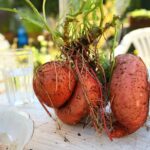Are you looking for an easy and natural way to add sweetness to your favorite recipes? Growing stevia right in your garden could be the perfect solution! This herb has been used as a natural sugar substitute for centuries and is now becoming a popular choice among health-conscious individuals. Not only is it calorie-free and full of nutrients, but it is also surprisingly easy to grow! In this article, we’ll discuss how to grow stevia in your own garden, from planting the seeds all the way through harvesting.
If you’ve ever wanted to experience the joys of growing your own food or herbs, stevia could be a great choice for you. It requires very little maintenance and can thrive in almost any climate. Plus, it is incredibly rewarding to pick fresh leaves whenever you need them for your favorite recipes. From smoothies to salads, adding sweetness with homegrown stevia adds a special touch that store-bought versions just don’t have.
With just a few simple steps, you can easily have your own patch of this healthy herb growing in no time! Read on to learn more about how to grow organic stevia right in your own garden.
What Is Stevia?
Stevia is an herb native to South America that has been used for centuries as a sweetener. It’s becoming increasingly popular as a natural sugar substitute due to its low calorie count, and it also has a range of health benefits. Growing stevia in your own garden is easy and can provide you with your own supply of this versatile herb.
The first step to growing stevia is to understand the different types available. Stevia rebaudiana is the most popular type, and it’s what you’ll find in commercial products. There are also other species, such as Stevia serrata, which have similar characteristics but different flavors. Each variety will have specific planting requirements and requirements for climate and soil type.
When you decide which type of stevia you want to grow, select an area in your garden that receives full sun or partial shade, depending on the species’ needs. Make sure the soil is well-drained and rich in organic matter and that there are no weeds nearby that could interfere with growth. Planting stevia from seeds or cuttings is best done in early spring or late summer when temperatures are milder.
Once planted, take care to keep the soil moist but not soggy by providing regular waterings throughout the growing season. Fertilize periodically with an organic fertilizer or compost tea to ensure healthy growth of your plants. Pruning will help keep them manageable size-wise; simply trim off any dead or overgrown stems at their base while leaving healthy foliage intact. With proper care, you can enjoy a steady supply of fresh stevia right from your own garden!
Benefits Of Growing Stevia In Your Garden
Growing your own stevia has a lot of benefits. Not only can you save money, but you can be sure that the stevia is organic and grown without any harsh chemicals. Plus, you’ll know exactly what went into the growing process, and you can tailor it to your specific needs.
Besides all these advantages, planting your own stevia brings an added sense of satisfaction when harvesting the leaves and using them in your cooking or tea. You’ll also get to enjoy watching the plant grow throughout the season and appreciate its beauty in your garden or flower bed.
You don’t even need a lot of space for this herb – just choose a spot in direct sunlight with well-draining soil and plenty of room for root growth. And remember: plants need water too! With proper care and attention, growing your own stevia can bring a bounty of sweet rewards.
Selecting A Location For Growing Stevia
Ahh, the joy of growing your own stevia! There’s nothing quite like it. Picture yourself walking through a lush garden full of sweet-smelling stevia plants – it’s an absolute paradise! But before you can start envisioning that dreamy scenario, you must first find the perfect location for your stevia plants.
Finding the right spot for your stevia is important because it will determine how well they grow and how much success you’ll have with harvesting. The ideal environment for stevia should be in a sunny area, shielded from strong winds and other extreme weather conditions. It should also have well-drained soil with plenty of organic matter to ensure the roots are getting the nutrients they need.
When choosing a spot for your stevia plants, make sure to consider any nearby trees or shrubs that could provide shade during certain times of day or seasonally. Also keep in mind that some varieties of stevia require more water than others, so if you’re planting in an area that tends to be drier, you may want to choose drought-tolerant varieties instead. With careful thought and planning, selecting the right location for growing stevia can help ensure a successful harvest.
Now that you’ve got the perfect spot picked out, all that’s left is deciding when to plant your stevia!
When To Plant Stevia
When it comes to planting stevia, timing is key. It’s best to plant the herb when outdoor temperatures remain consistently above 60°F. Generally, this time falls between April and May for most parts of the US. If you live in a warmer climate, you can plant stevia earlier in the spring. It’s important to note that stevia prefers a long growing season, so make sure your planting date allows enough time for the herb to mature before cold weather sets in.
It’s also a good idea to wait until after the last frost of the season has occurred in order to ensure success with your stevia crop. If you’re unsure when the last frost of winter will happen, check out your local gardening store or extension office for more information on frost dates specific to your region.
Once it’s safe to plant stevia, get ready! All that remains is deciding what type of soil is best for your new herb garden.
What Type Of Soil Is Best For Stevia?
As fate would have it, the success of growing stevia in your own garden all comes down to the type of soil used. While the natural sweetener is easy to grow, you must use the right type of soil for optimal results. Here’s what you need to know about growing stevia in your garden.
Finding a soil that works well with stevia is key. It should be rich in organic matter with a slightly acidic pH (5.5-7). The soil should also be well-draining and moist without being soggy or overly wet. With these conditions met, the stevia plant should thrive and produce large amounts of leaves throughout the season.
Compost is an excellent way to provide essential nutrients to your plants while also improving drainage and aeration in soil that may be too compacted for proper growth. However, if compost isn’t available, you can always use manure or mulch instead. Both will help improve drainage and aeration while providing essential nutrients needed for strong healthy plants.
With the right type of soil at hand, you can now move on to planting your stevia seeds or cuttings and ensure that they get all the necessary resources for optimum growth!
How To Plant Stevia
Planting stevia is surprisingly easy, and doesn’t require a green thumb. You’ll need to prepare the soil before getting started; it should be well-drained and slightly acidic, with a pH of 6.0-7.5. Once your soil is ready, you can begin planting your stevia. It’s best to start with seeds or cuttings rather than transplanting established plants. Plant the seeds in small pots and keep them moist until they germinate, which can take up to two weeks. When the seedlings are about 4 inches tall, they’re ready to be transplanted into the garden or larger pots. Be sure to give them enough space between plants for adequate airflow and sun exposure – spacing should be at least 12 inches apart for outdoor gardens and 6 inches for container gardens.
Transplanting stevia requires some care; dig a hole deep enough to accommodate the roots without crowding them, then add compost or fertilizer to help nourish the plant in its new home. Gently press down on the soil around the root ball before watering generously to settle everything in place. Finally, use mulch around each plant to retain moisture and suppress weeds – this will also help protect against extreme temperatures if you live in areas with cold winters or hot summers.
Now that your stevia is planted in its ideal environment, it’s time to start caring for it properly! Regular watering is essential for healthy growth – water deeply but not too frequently so as not to overwater your plants – aim for once per week during periods of drought and every other day during periods of heavy rainfall.
How To Water Stevia
Watering stevia is an important step to ensure that the plant thrives. The amount of water needed will depend on a few factors, such as the climate and soil type. In hotter climates, stevia may need to be watered more often. If you’re growing it in a pot, you’ll need to water it more frequently. When watering, make sure the water reaches the root zone and not just the leaves. This ensures that the roots absorb all of the moisture they need.
For optimal growth, stevia should get about one inch of water per week, either from rainfall or irrigation. If you are using a hose or sprinkler system for irrigation, make sure to avoid over-watering as this can lead to root rot and other issues with your plants. Additionally, avoid watering during hot periods in the day – early morning is best.
These guidelines should help you keep your stevia plants well-watered and flourishing! With proper hydration and care, you can have healthy stevia plants in no time at all. Now it’s time to move onto tips for harvesting stevia – a process that’s essential for producing its sweet flavor.
Tips For Harvesting Stevia
Harvesting sweet stevia leaves is like harvesting a bounty of sunshine; you’ve been nurturing your plants with the right amount of water and sunlight and now it’s time to reap the rewards. When it comes to harvesting stevia, timing is key. You should be harvesting when the flowers are beginning to open, as this is when the leaves will have the most sweetness. Here are some tips for successful stevia harvesting.
First, wait for the plant to reach at least 8 inches in height before snipping off any stems. Then, use sharp scissors or pruners to cut away from each stem, leaving at least two sets of leaves on each stem so that the plant can continue growing. If you plan on drying your stevia leaves for later use, cut more than you think you’ll need since the leaves lose about half their weight during drying.
After cutting your stems, hang them upside down in a warm and dry place such as an attic or garage until they’re completely dry (this should take about two weeks). Once they’re ready, store them in airtight containers away from light and heat sources. With these simple steps, your homegrown stevia harvest will be ready to enjoy!
How To Use Stevia
Starting to imagine the sweet taste of stevia in your cup of tea, or a delicious dessert? Growing stevia in your own garden is a great way to get the most out of this herb. But once it’s ready for harvest, what do you do with it? In this final step, we’ll look at how to use stevia in your home.
To start off, you can steep the leaves and stems (or even the entire plant) in hot water. Let it sit for 10 minutes before straining out the leaves and stems. This will provide a sweet-tasting liquid that can be used as a natural sweetener for coffee, tea, smoothies, or any other drink you’d like to add sweetness to. Or if you prefer a sweeter syrup-like consistency, boil the mixture until it reduces and thickens into syrup.
Another way to use stevia involves drying out the leaves and grinding them into powder form. It’s best to leave them outside on a sunny day or use a dehydrator as it helps retain more flavor from the fresh plant. Once dried out, grind them up with a mortar and pestle until they become fine powdery flakes – which can then be added directly into drinks or recipes for an extra sweetness boost!
We’ve now come to the end of this step on using stevia in your home – but there are still many things to consider before starting your own garden full of these sweet herbs. The next section will cover common problems with growing stevia so that you have all the information needed to get started!
Common Problems With Growing Stevia
Growing stevia can be a rewarding experience, but it’s not without its challenges. Common problems with growing stevia include lack of pollination, poor soil conditions, and pests. Let’s take a closer look at each of these issues.
Pollination is key for successful stevia cultivation. Without proper pollination, the flowers won’t produce seeds or viable plants. To ensure this doesn’t happen, you should look into planting different varieties of the herb to encourage pollinators like bees and butterflies to your garden.
Good soil conditions are also important for growing stevia successfully. The soil should be rich in organic matter and well-draining to provide adequate nutrients to the plant and keep moisture levels balanced. If you notice wilting leaves or stunted growth, then it may be time to amend your soil with compost or fertilizer.
Finally, pests can be a real nuisance for any gardener trying to cultivate stevia. Aphids and spider mites are common culprits when it comes to damaging plants like stevia. Regularly spraying insecticidal soap and neem oil around your garden can help ward off these pests and make sure your crops stay healthy and thriving!
Troubleshooting Tips For Growing Stevia
Troubleshooting tips for growing stevia can be a helpful guide to ensure success in your garden. To start, it is important to understand the common problems that may arise while cultivating stevia. Poor drainage and too much shade are two of the most common issues that can lead to stunted growth, as well as disease and pests. Additionally, if you don’t provide enough water or nutrients, your plants won’t thrive.
When dealing with these issues, it’s important to take action quickly. For instance, make sure that your soil is well-draining and not overly wet. If more sun is needed, consider moving plants to a sunnier spot or supplementing with artificial lighting. You should also make sure your plants are getting adequate water and fertilization so they can reach their full potential.
In addition to addressing these primary issues, keep an eye out for signs of disease or pests on your stevia plants. If you do notice any problems, take steps to treat them immediately in order to prevent further damage from occurring. By following these troubleshooting tips, you’ll be able to effectively resolve any problems that come up while growing stevia in your garden. With proper care and attention, you’ll be rewarded with a bountiful harvest of sweet leaves!
Best Companion Plants For Growing With Stevia
Did you know that over 150 species of plants and herbs can be used to accompany stevia when growing in the garden? These companion plants help create a more vibrant, healthy, and productive environment for your stevia plant. In this article, we’ll discuss the best companion plants for growing with stevia.
One popular companion plant for stevia is garlic. Garlic has many benefits for both the soil and the health of other plants grown around it. It helps to ward off pests and diseases while improving soil fertility by providing nutrients like nitrogen, phosphorus and potassium. Additionally, garlic provides a natural fertilizer that helps to increase the growth of other plants around it. Garlic also acts as an organic insect repellent making it ideal for keeping away harmful bugs from attacking your stevia plant.
Another great companion plant for stevia is Basil. Basil contains several compounds that are beneficial to other plants near it, such as thymol which helps reduce fungal disease on nearby crops. Additionally, basil can help attract pollinators like bees which can improve pollination rates in your garden and result in better yields of fruit or vegetables grown around your stevia plant. Lastly, basil produces essential oils which have antifungal properties and may help prevent certain types of diseases from affecting nearby crops.
These are just some examples of what companion plants you can use when growing stevia in your own garden. There are many more options out there that offer similar benefits so be sure to do your research before deciding which ones will work best for you! With the right combination of companion plants along with careful tending, you can ensure that your stevia plant grows strong and healthy season after season.
How To Preserve Stevia
Stevia is like a beautiful rose, in that it takes tender nurturing to grow and blossom. To ensure its beauty and flavor can be enjoyed by all, one must take the necessary steps to preserve it. With the proper techniques, stevia can provide us with a sweet treat for many years.
As with roses, when preserving stevia it’s important to start off right. When harvesting, make sure not to pull up too much of the root system as this can damage the plant’s ability to regrow next season. Once harvested, rinse off any dirt or debris from the leaves then lay them out on parchment paper or other absorbent material to dry. Make sure to turn them over every few hours so they dry evenly on both sides.
When you see that the leaves have curled slightly inward and feel brittle but still have some green coloration, they are ready for storage. Place them in an airtight container such as a jar or zip-top bag and store them in a cool dark place away from direct sunlight or heat sources. Doing this will help maintain their flavor for several months until you’re ready to use them again.
Preserving stevia requires patience and care – just like caring for a rose – but with these tips you’ll be able to enjoy its sweetness all year round! With proper preservation techniques in hand, it’s now time to move onto propagating stevia which will produce even more of this delightful herb over time.
Tips For Propagating Stevia
The sweet, herbal scent of stevia fills the air as you enter your garden. A lush patch of green greets you, filled with delicate foliage that sways in the breeze. It’s time to propagate more stevia so that this fragrant wonder can continue to grow and thrive. Here are some tips for propagating stevia for a bountiful harvest.
When propagating stevia, start by choosing healthy plants from which to take cuttings. The ideal time is when the stems are still tender and flexible, making them easy to work with. Cut off sections that are at least four inches long and make sure each has two or three leaves on it. Dip the ends of the cuttings into a rooting hormone before planting them in moist soil or compost.
In order to ensure successful propagation, it’s important to provide the cuttings with plenty of light and keep the soil consistently moist. To encourage root growth, mist the soil lightly every day or place a plastic bag over the cutting to create a humid environment. If all goes well, new roots should emerge within three weeks and you’ll be able to transplant your cuttings into their permanent location soon after!
Propagating stevia is not only satisfying but also ensures that these flavorful herbs remain part of your garden for years to come. With a few simple steps and attentive care, you’ll be able to reap the rewards of these fragrant plants for many harvests down the road! Now that propagation is taken care of, let’s look at what else needs doing in order to keep your stevia thriving through its off-season.
What To Do In The Off-Season For Stevia
Have you ever wanted to grow your own natural stevia but wondered what to do in the off-season? We’ve all heard the phrase ‘preparation is key’, and when it comes to growing stevia, that is certainly true! Investigate this theory and explore what needs to be done in order for your stevia plant to thrive.
In the off-season, keep an eye on your stevia plants for any signs of disease or damage. If you spot any issues, take care of them right away so that the health of your plants doesn’t deteriorate. Additionally, prune back the dead leaves and stems on a regular basis so that more nutrients can reach the rest of the plant. This will help ensure that your plant remains healthy throughout the off-season.
Finally, fertilize your stevia plants every few weeks during their off-season. Doing this will give them enough nutrients to sustain themselves until they’re ready to be planted again in springtime. Make sure you use a fertilizer specifically designed for herbs and vegetables as regular fertilizers could damage the delicate roots of your stevia plants. Taking these steps will ensure that when it’s time to move forward with planting again, you’ll have healthy and thriving plants ready for success!
Frequently Asked Questions
How Much Stevia Can I Expect To Harvest From One Plant?
Growing stevia in your own garden can be like taking a sweet trip down memory lane. Not only will you enjoy the nostalgia of gardening, but also the benefit of harvesting your own natural stevia. How much can you expect to harvest from one plant? Let’s take a look.
When it comes to harvesting, the amount varies depending on several factors such as climate and growing conditions. Generally speaking, an individual stevia plant can yield up to two tablespoons of dried leaves per year. However, this could be more or less depending on how well the plant is taken care of and grown. For example, if the soil is kept moist and the plant receives adequate sunlight then you may be able to get even more out of it.
Stevia is also a perennial which means that it will come back year after year if properly cared for – so with time, patience and dedication you should be able to reap quite a bit from just one plant over its lifetime! With proper maintenance and harvesting techniques in place you may find that your little plot of land is full of sweetness all year round!
Does Stevia Attract Pests?
If you’re considering growing stevia in your garden, one of the questions that may come to mind is whether or not it attracts pests. It’s a valid concern, and one worth exploring before getting started.
The good news is that when grown correctly, stevia rarely has issues with pests. In fact, this sweet herb can actually help repel certain insects from other plants in your garden due to its strong scent. That said, if you don’t provide enough nutrients and light, or if there are other factors like extreme temperatures or high humidity levels, then it may be more prone to pest problems.
Therefore, it’s important to ensure that your stevia plants are provided with plenty of nutrition and light while also taking steps to control the environment they’re growing in. Doing so will help keep away any unwanted pests and allow you to enjoy a bountiful harvest of sweet stevia leaves!
How Often Should Stevia Be Fertilized?
When it comes to growing stevia, fertilizing is an important part of the process. The frequency of fertilizer applications depends on the type of soil and the specific needs of your stevia plant. If you’re unsure how often to fertilize, it’s best to start with a light application every two weeks.
To ensure optimal growth for your stevia plant, use a balanced fertilizer that contains nitrogen, phosphorus, and potassium. This will provide all the necessary nutrients for your plant to thrive and produce more leaves and flowers. Additionally, adding organic matter such as compost or manure can help improve soil fertility over time.
It’s also important to monitor soil pH levels when fertilizing stevia plants as this plays a role in nutrient availability. Your local nursery should be able to provide advice on which type of fertilizer to use and how often you should apply it for best results. With proper care, your stevia plants should be able to reach their full potential and produce plenty of sweet-tasting leaves!
How Long Does It Take For Stevia To Reach Maturity?
Growing stevia in your own garden is a great way to enjoy its natural sweetness. But if you want to get the most out of your plants, knowing when and how long it takes for them to reach maturity is important. In this article, we’ll discuss how long it typically takes for stevia to reach maturity.
Stevia is a relatively fast-growing plant that can be ready for harvest within 4-6 months from seedling. It’s important to note, however, that the exact amount of time depends on the variety you’ve chosen and growing conditions like temperature and humidity. For example, cooler climates may take longer for stevia to reach full maturity than warmer climates.
It’s also important to remember that even once your stevia has reached full maturity, it will continue to grow until it goes dormant during the winter season. To ensure optimal growth and sweetness of your plants, regular maintenance such as fertilizing and pruning should be done throughout the growing season. All these factors taken together will help you determine when it’s best to harvest your homegrown stevia so you can enjoy its natural sweetness all year round!
Can Stevia Be Grown In Containers?
Growing stevia doesn’t have to be an impossible task – it can be done right in your own garden! With a little patience and knowledge, you can have a thriving stevia plant in no time. But before you get started, there’s one important question that needs to be answered: Can stevia be grown in containers? Absolutely! In fact, growing stevia in pots can be even easier than planting it directly into the ground.
Gardening with a container is great for those with limited outdoor space, or if you just want to make sure your plant gets all the care and attention it needs. Plus, it’s incredibly rewarding – not only will you feel like a master gardener when you watch your stevia thrive in its new home, but you’ll also get to enjoy its sweet taste once it’s mature!
Container-grown stevia requires the same amount of water as ground-planted plants, so make sure to keep an eye on soil moisture levels. You should also prune your plant regularly to ensure healthy growth and fullness. With these simple steps, you’ll have an abundant harvest of natural sweetness that will last for years to come! So don’t let limited space stop you from getting your green thumb fix – growing stevia in containers is totally doable and absolutely delicious!
Conclusion
Stevia is an incredibly versatile and popular sweetener that can be grown right in your own garden. With minimal effort, you can enjoy a steady supply of fresh, natural stevia for years to come. This is especially helpful considering the fact that one plant can yield up to 6 ounces of dried leaves per year! While Stevia does require regular watering and fertilizing, it is not prone to pest infestations and can even be grown in containers.
To wrap up, growing your own stevia is a great way to enjoy its sweetness without having to worry about the sugar content or artificial ingredients found in store-bought options. Plus, with an average flowering time of just three weeks, you’ll have plenty of time to harvest your own natural sweetener before the season ends. So what are you waiting for? Start growing your own stevia today and reap the health benefits of this amazing plant!





























